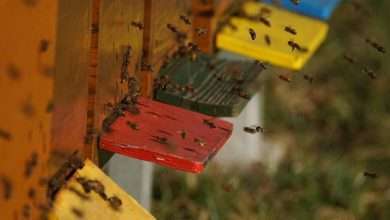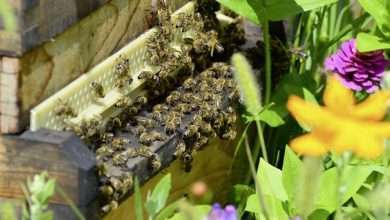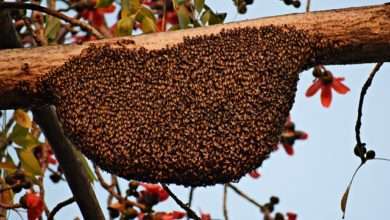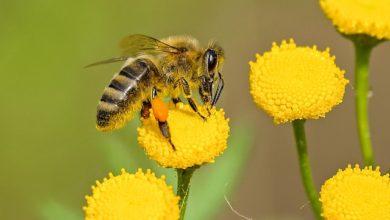Has Your Dog Been Stung by Bees
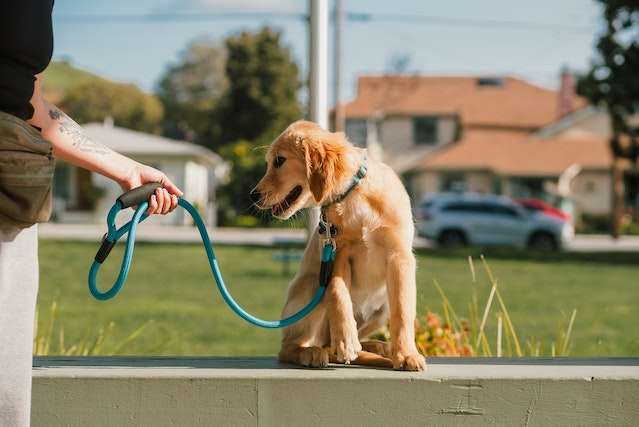
Dogs love exploring the world around them, sniffing out new scents and chasing after anything that moves. Unfortunately, their natural curiosity can lead them into dangerous situations, such as getting stung by bees.
As a beekeeper, I am always around bees, and my dog usually follows me out to the bee yard.
My dog, as a puppy, decided one day to snap at bees. He seemed to enjoy it until he was stung on the tongue. Now, he keeps his distance from the bee yard.
It’s important for pet owners to know how to identify, treat, and prevent bee stings in dogs to ensure their pet’s health and wellbeing.
Importance of Identifying Bee Stings in Dogs
Bee stings are a common problem that many dogs will face. Unfortunately, dogs are allergic to bee stings, which could cause medical issues.
However, many pet owners often fail to identify bee stings in their pets, making it challenging to provide the necessary medical care.
Symptoms of Bee Stings in Dogs
Identifying the symptoms of bee stings in dogs is essential in providing the necessary medical attention to your pets.
Typically, dog bee stings have two types of reactions: local and systemic.
Local Reactions
When a dog is stung by a bee, a raised welt usually appears at the site of the sting. The affected area becomes painful, inflamed, and red, and dogs may also show the following symptoms:
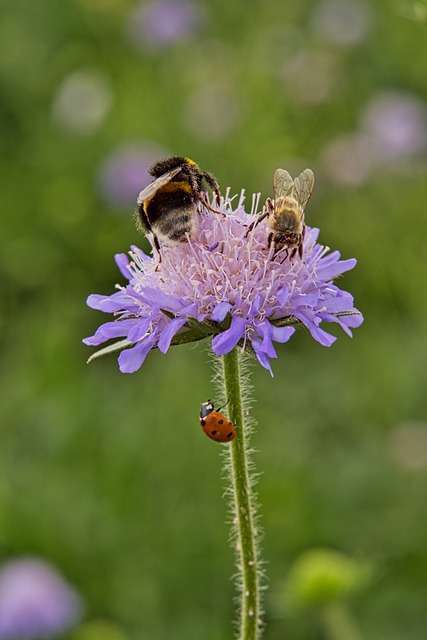
- Swelling or hives in the area
- Itching
- Excessive Licking or scratching at the sting site
- Mild to moderate pain
Systemic Reactions
A systemic reaction to bee stings is rare but can happen. Unlike a local response, the symptoms and effect of systemic responses can be severe, such as:
- Swelling in the face, neck, or head
- Trouble breathing, coughing, or vomiting
- Rapid heart rate
- Shock or unconsciousness
Types of Bees and their Venom
There are several types of bees that can sting dogs. The most common ones are honey bees, bumblebees, and yellow jackets. Honey bees are the most common type of bee stings in dogs, and their venom is acidic.
Bumblebees have a less severe sting than honey bees, and their venom is alkaline. Yellow jackets have a potent venom, and their stingers are barbed. The venom from a yellow jacket sting has a combination of both acid and alkaline properties.
Causes of Bee Stings in Dogs
Bees sting because they feel threatened or provoked. These stinging insects are found outdoors where dogs frequently play, making it common for dogs to get stung while they are outside.
Some of the reasons dogs may get stung by bees include:
- Chasing bees
- Sniffing or investigating bees
- Accidentally stepping on or sitting on a bee
What to Do If Your Dog Gets Stung by Bees
As much as we want to protect our furry friends from harm, sometimes accidents happen, and our dogs may end up getting stung by bees. It could be while they are on walks, sniffing around your garden, or accidentally stepping on a bee while playing. Whatever the case may be, it is essential to know how to provide first aid in such an emergency.
First aid measures
1. Identifying the affected area
- The first thing you need to do is identify the area where your dog got stung. Bees usually leave their stinger behind in the skin, which can cause pain and discomfort. Look out for the stinger around the affected area, which is usually visible to the naked eye.
2. Removing the stinger
- It is crucial to remove the stinger as soon as possible to reduce the severity of the symptoms. You can use a pair of tweezers or scrape the area with a credit card or nail file to remove the stinger. Do not use your fingers to remove it as it could squeeze more venom into the skin.
3. Applying basic first aid
After removing the stinger, it’s necessary to apply basic first aid to the affected area.
Localized reactions are typically treated with:

- Applying a cold compress on the affected area to ease the pain and swelling.
- Use of an antihistamine to relieve the itchiness and hives.
- Use of pain relieving cream or gel for mild to moderate pain.
When to Seek Veterinary Help
Even after providing first aid, you should monitor your dog’s symptoms closely. In some cases, a single bee sting might not cause any severe harm, but in some cases, the symptoms can be life-threatening. Here are some situations when you should seek veterinary help.
1. Severe Symptoms
If your dog exhibits severe symptoms like difficulty breathing, swelling in the face or throat, vomiting, or collapse, seek veterinary help immediately. These symptoms could be an indication of an allergic reaction, which can be life-threatening if not treated promptly.
Treatment may include:
- Administering epinephrine for an anaphylactic shock reaction
- Giving oxygen or intravenous fluids for signs of shock
- Using steroids to decrease inflammation
- Close monitoring of the dog’s vital signs and blood pressure
2. Repeated bee stings
If your dog has been stung multiple times, it’s essential to visit your vet. Repeated bee stings can cause a build-up of venom in the system, leading to severe symptoms like anaphylactic shock.
Preventing Bee Stings in Dogs
Preventing bee stings in dogs can be challenging because they love exploring and chasing after anything that moves.
The good news is that there are several strategies you can use to keep bees away from your pooch.
- Trim the Grass
Tall grass could lure bees to your backyard, where they could set up hives. If your dog loves to play or laze in tall grass, it’s best to keep it short. Regularly trim your grass to discourage bees from considering your yard a potential habitat.
- Keep Food and Drinks Covered
Bees love sweet food and drinks. If you have a sweet tooth and love to snack outdoors, you should cover your food and drinks to discourage bees from coming over. Similarly, if you give your dog sweet treats, make sure you give them indoors or in a screened area to reduce the chances of attracting bees.
- Know Your Plants and Flowers
Some plants and flowers are bee magnets. If you’re a fan of flowers, it’s best to plant varieties that do not attract bees. Some of the best plants to use include marigolds, citronella, and eucalyptus. These plants not only repel bees but also other insects like mosquitoes.
- Keep Your Yard Tidy
A tidy yard is not only aesthetically pleasing but also discourages bee activity. Bees love to settle in areas with debris and clutter, so it’s best to keep your yard tidy at all times. Make sure to remove any trash, especially food waste, and keep your pet’s toys organized.
You can also make your dog wear a protective suit, such as a mesh jacket or a beekeeper suit, when they are outside. These suits are designed to cover the dog’s fur and prevent bees from getting close to their skin.
Conclusion
Bee stings in dogs are a common occurrence, but they can be easily treated and prevented with some simple precautions.
Identifying the symptoms of a bee sting, taking immediate action to remove the stinger and clean the affected area, and providing appropriate treatment are essential to your dog’s health and wellbeing.

By following these tips and taking preventative measures, you can help keep your dog safe and healthy while they explore the world around them.
FAQ
Can Bee Stings be dangerous to dogs?
- Yes, bee stings can be very dangerous to dogs. In severe cases, they can cause allergic reactions that can lead to life-threatening anaphylactic shock.
How do I know if my dog is having an allergic reaction to a bee sting?
- Signs of an allergic reaction to a bee sting in dogs include difficulty breathing, weakened pulse, seizures, vomiting, and collapse. Seek veterinary care immediately if you suspect your dog is having an allergic reaction.
Can I use human bee sting products on my dog?
- It is not recommended to use human bee sting products on your dog, as they are formulated for human use and may contain ingredients that are toxic to dogs.
Can dogs eat bees?
- It is not recommended for dogs to eat bees as it may lead to a bee sting in their mouth or throat, causing swelling and potential breathing difficulties.
Why does my dog chase bees?
- Dogs may chase after bees due to their natural prey drive, curiosity, or even boredom. It is important to discourage this behavior to prevent potential injuries.
